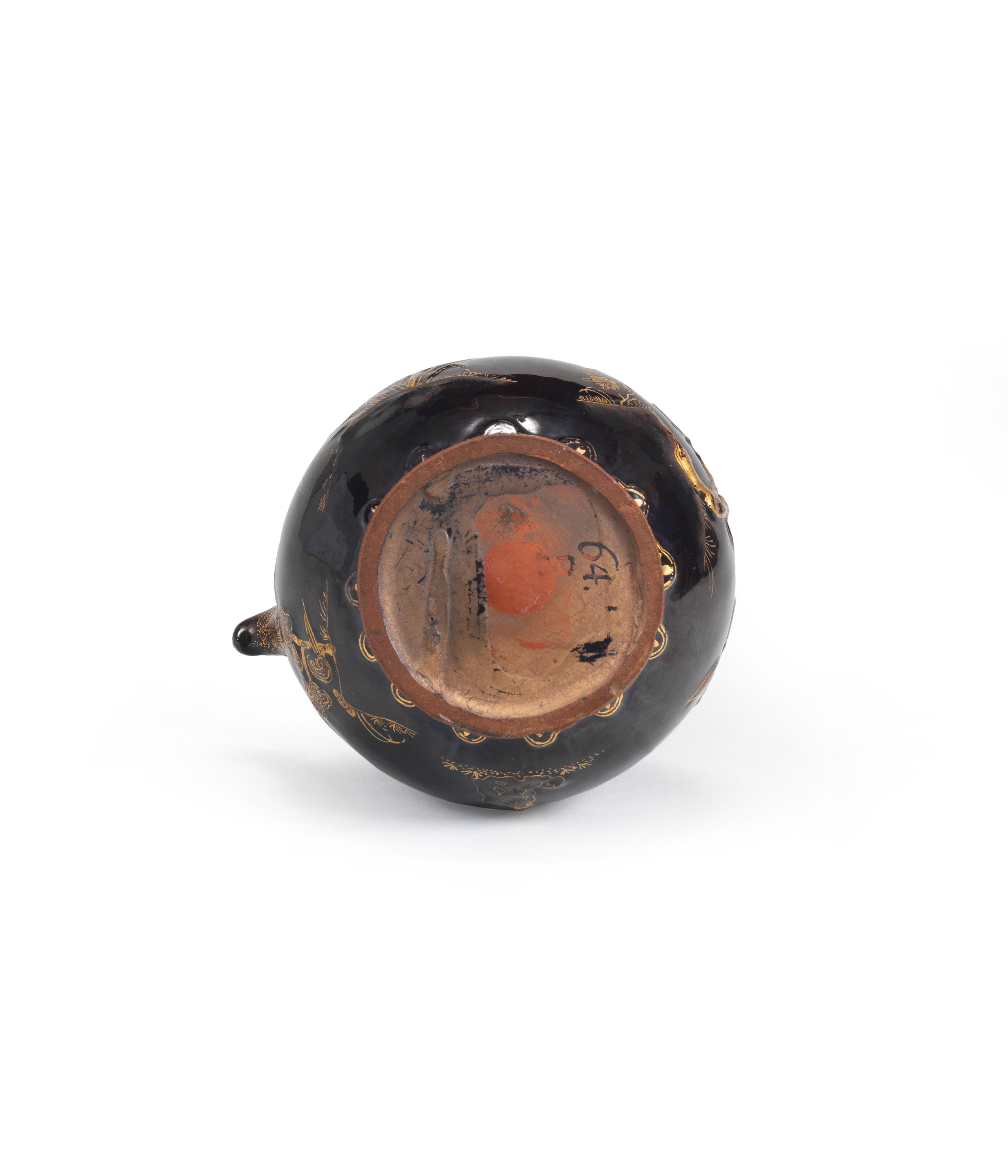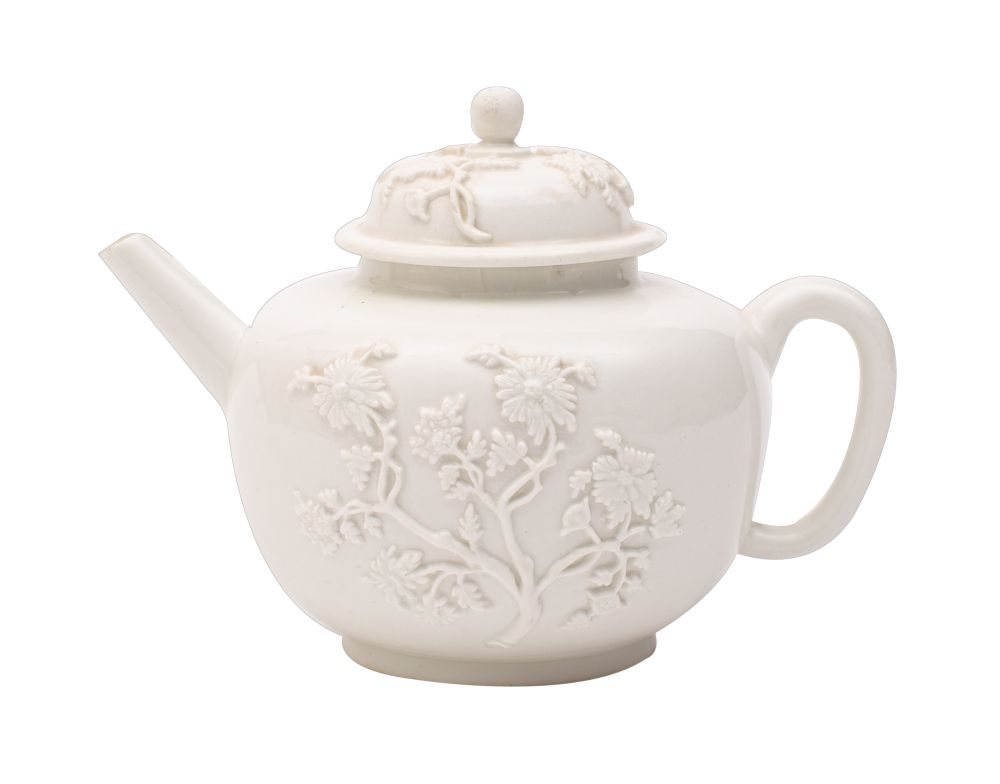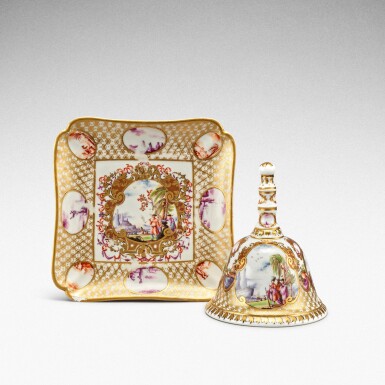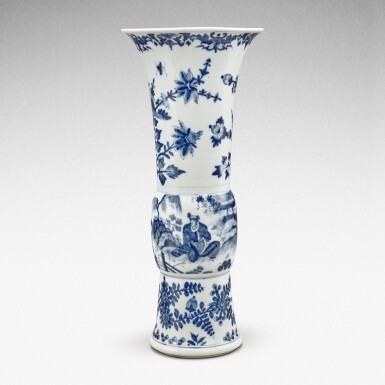A rare Meissen Böttger stoneware teapot and cover, circa 1710-13 The bell-shaped body with an ear-shaped handle and curved spout, engraved, cut and polished with foliate motifs and dots scroll- and strapwork below a border of swags around the shoulder and dots below the rim, the spout, handle and flat cover similarly decorated, 9.5cm high, (tiny chip to tip of spout) (2) Fußnoten Provenance: Acquired between 1717-1719 by Franceso Bernardi, called il Senesino (1686-1758); Thence by descent until acquired by the present owner For a detailed discussion of the cutting and faceting of Böttger stoneware, see Rainer Rückert, Biographische Daten der Meißener Manufakturisten des 18. Jahrhunderts (1990), pp. 90-92. Böttger engaged artists in Dresden as well as from Bohemia, and the work - after Böttger's own designs - was carried out in Dresden as well as in the Albrechtsburg in Meissen. The shape is based on a Chinese, Kangxi (1662-1722) teapot with underglaze-blue decoration from the collection of Augustus the Strong with the Japanese Palace inventory number N:549 (Staatliche Kunstsammlungen Dresden, Porzellansammlung, inv. no. PO 2684). Numerous examples of the shape (called 'Glocken Thee Krügel' are listed in the 1711 inventory of the manufactory (C. Boltz, Formen des Böttgersteinzeugs im Jahre 1711, in Mitteilungsblatt der Keramikfreunde der Schweiz 96 (1982), p. 23), and three are listed in the inventory of the Japanese Palace under no. 149: 'Drey Stück [Thee Potgen] runde geschliffene, different, mit Deckel, Henckel und Schnauze, wovon eins mit einem silbernen Kettel versehen, 4 1/2. Zoll och, 3 1/2. Zoll in Diam: No. 149 [three (tea pots) round, polished, different, with cover, handle and spout, of which one is decorated with a silver chain] (quoted by C. Boltz, Japanisches Palais-Inventar 1770 und Turmzimmer-Inventar 1769, in Keramos 153 (1996), p. 106). Two similar teapots remain in the Dresden collection (inv. nos. P.E. 783 and P.E. 5756, the first is published by I. Menzhausen, Alt-Meißner Porzellan in Dresden (1988), no. 6). Another was sold by Sotheby's Zürich, 21 November 1990, lot 39. Il Senesino Francesco Bernardi called 'il Senesino' was born in Siena in 1686, and started his musical careeer when he joined the cathedral choir at the Duomo in Siena in 1695. He was castrated at the relatively late age of 13. His debut was in Venice in 1707, and during the next decade his European reputation grew. By the time he sang in Lotti's Giove in Argo in 1717 at Dresden, he could command an equally enormous salary of 7000 Thaler. It was during this time that he most likely acquired or was given the Böttger stoneware teapot. As with many castrati, reports of Senesino's acting were not always positive, to say the least. The impresario Count Francesco Zambeccari wrote of his performance in Naples in 1715: "Senesino continues to comport himself badly enough; he stands like a statue, and when occasionally he does make a gesture, he makes one directly the opposite of what is wanted." Of the singer's vocal abilities, however, there was no doubt. In 1719, the composer Quantz heard him in Lotti's Teofane at Dresden, and stated: "He had a powerful, clear, equal and sweet contralto voice, with a perfect intonation and an excellent shake. His manner of singing was masterly and his elocution unrivaled. ... he sang allegros with great fire, and marked rapid divisions, from the chest, in an articulate and pleasing manner. His countenance was well adapted to the stage, and his action was natural and noble. To these qualities he joined a majestic figure; but his aspect and deportment were more suited to the part of a hero than of a lover." Following a dispute with the court composer Heinichen in 1720 over an aria in the opera Flavio Crispo that led to his dismissal, Senesino was engaged by Handel as primo uomo (lead male singer) in his company, the Royal Academy of Music. He made his first appearance in a revival of Radamisto on 28 December, and h
A rare Meissen Böttger stoneware teapot and cover, circa 1710-13 The bell-shaped body with an ear-shaped handle and curved spout, engraved, cut and polished with foliate motifs and dots scroll- and strapwork below a border of swags around the shoulder and dots below the rim, the spout, handle and flat cover similarly decorated, 9.5cm high, (tiny chip to tip of spout) (2) Fußnoten Provenance: Acquired between 1717-1719 by Franceso Bernardi, called il Senesino (1686-1758); Thence by descent until acquired by the present owner For a detailed discussion of the cutting and faceting of Böttger stoneware, see Rainer Rückert, Biographische Daten der Meißener Manufakturisten des 18. Jahrhunderts (1990), pp. 90-92. Böttger engaged artists in Dresden as well as from Bohemia, and the work - after Böttger's own designs - was carried out in Dresden as well as in the Albrechtsburg in Meissen. The shape is based on a Chinese, Kangxi (1662-1722) teapot with underglaze-blue decoration from the collection of Augustus the Strong with the Japanese Palace inventory number N:549 (Staatliche Kunstsammlungen Dresden, Porzellansammlung, inv. no. PO 2684). Numerous examples of the shape (called 'Glocken Thee Krügel' are listed in the 1711 inventory of the manufactory (C. Boltz, Formen des Böttgersteinzeugs im Jahre 1711, in Mitteilungsblatt der Keramikfreunde der Schweiz 96 (1982), p. 23), and three are listed in the inventory of the Japanese Palace under no. 149: 'Drey Stück [Thee Potgen] runde geschliffene, different, mit Deckel, Henckel und Schnauze, wovon eins mit einem silbernen Kettel versehen, 4 1/2. Zoll och, 3 1/2. Zoll in Diam: No. 149 [three (tea pots) round, polished, different, with cover, handle and spout, of which one is decorated with a silver chain] (quoted by C. Boltz, Japanisches Palais-Inventar 1770 und Turmzimmer-Inventar 1769, in Keramos 153 (1996), p. 106). Two similar teapots remain in the Dresden collection (inv. nos. P.E. 783 and P.E. 5756, the first is published by I. Menzhausen, Alt-Meißner Porzellan in Dresden (1988), no. 6). Another was sold by Sotheby's Zürich, 21 November 1990, lot 39. Il Senesino Francesco Bernardi called 'il Senesino' was born in Siena in 1686, and started his musical careeer when he joined the cathedral choir at the Duomo in Siena in 1695. He was castrated at the relatively late age of 13. His debut was in Venice in 1707, and during the next decade his European reputation grew. By the time he sang in Lotti's Giove in Argo in 1717 at Dresden, he could command an equally enormous salary of 7000 Thaler. It was during this time that he most likely acquired or was given the Böttger stoneware teapot. As with many castrati, reports of Senesino's acting were not always positive, to say the least. The impresario Count Francesco Zambeccari wrote of his performance in Naples in 1715: "Senesino continues to comport himself badly enough; he stands like a statue, and when occasionally he does make a gesture, he makes one directly the opposite of what is wanted." Of the singer's vocal abilities, however, there was no doubt. In 1719, the composer Quantz heard him in Lotti's Teofane at Dresden, and stated: "He had a powerful, clear, equal and sweet contralto voice, with a perfect intonation and an excellent shake. His manner of singing was masterly and his elocution unrivaled. ... he sang allegros with great fire, and marked rapid divisions, from the chest, in an articulate and pleasing manner. His countenance was well adapted to the stage, and his action was natural and noble. To these qualities he joined a majestic figure; but his aspect and deportment were more suited to the part of a hero than of a lover." Following a dispute with the court composer Heinichen in 1720 over an aria in the opera Flavio Crispo that led to his dismissal, Senesino was engaged by Handel as primo uomo (lead male singer) in his company, the Royal Academy of Music. He made his first appearance in a revival of Radamisto on 28 December, and h











Try LotSearch and its premium features for 7 days - without any costs!
Be notified automatically about new items in upcoming auctions.
Create an alert